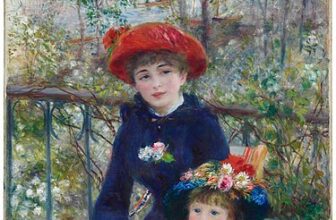
Paul Gauguin’s “Self-Portrait with Halo and Snake”
Paul Gauguin, celebrated as one of the pioneers of Post-Impressionism and a leading figure in the Symbolist movement, is renowned for his innovative use of color, form, and symbolism to express complex ideas and emotions. Among his most enigmatic works is the “Self-Portrait with Halo and Snake,” a captivating canvas that offers viewers a glimpse into the artist’s psyche and creative vision. Painted in 1889, during Gauguin’s sojourn in Tahiti, this masterpiece combines elements of autobiography, mythology, and spirituality to create a deeply personal and introspective portrait.
At first glance, Gauguin’s self-portrait appears to be a straightforward representation of the artist himself. He stands before the viewer with a solemn expression, his gaze fixed in the distance with a sense of quiet intensity. His features are rendered with Gauguin’s characteristic boldness and simplicity, capturing the essence of the man behind the canvas. Yet, it is the presence of the halo and snake that imbues the painting with a sense of mystery and intrigue, hinting at deeper layers of meaning beneath the surface.
The halo hovering above Gauguin’s head is a potent symbol of divinity and enlightenment, traditionally associated with saints, angels, and other holy figures in Christian iconography. Yet, in Gauguin’s self-portrait, the halo takes on a more ambiguous and open-ended meaning. Rather than representing divine grace or spiritual purity, the halo serves as a metaphor for Gauguin’s own artistic vision and creative genius. It illuminates his head like a beacon of light, symbolizing the transcendent power of art to elevate the human spirit and reveal deeper truths about the world.
The snake, coiled around Gauguin’s neck and shoulders, adds another layer of symbolism to the painting. In many cultures and mythologies, the snake is associated with knowledge, wisdom, and transformation—a potent symbol of the mysteries of life and the unconscious mind. In Gauguin’s self-portrait, the snake serves as a metaphor for the artist’s own inner turmoil and existential quest. It whispers secrets of the creative process into Gauguin’s ear, guiding him on a journey of self-discovery and artistic exploration.
Yet, the snake also carries darker connotations, symbolizing the temptations and contradictions of the human experience. In Christian iconography, the snake is often associated with the Fall of Man and the temptation of Eve in the Garden of Eden—a reminder of the inherent frailty and sinfulness of human nature. In Gauguin’s self-portrait, the snake serves as a reminder of the artist’s own struggles with morality, desire, and the pursuit of artistic truth.
The juxtaposition of the halo and snake in Gauguin’s self-portrait creates a tension and ambiguity that reflects the complexities of the artist’s own psyche. Throughout his life, Gauguin grappled with feelings of alienation, disillusionment, and spiritual longing, searching for meaning and purpose in a world that often seemed indifferent and hostile. In “Self-Portrait with Halo and Snake,” Gauguin confronts these existential dilemmas head-on, embracing the contradictions and paradoxes of his own nature with courage and defiance.
In many ways, “Self-Portrait with Halo and Snake” is a proof of Gauguin’s enduring legacy as a visionary artist and a pioneer of modernism. Through his bold use of symbolism and his fearless exploration of the human condition, Gauguin invites viewers to confront their own existential questions and to embrace the mysteries of life with an open heart and mind. In a world that often seems chaotic and uncertain, Gauguin’s self-portrait reminds us of the enduring power of art to illuminate the darkness and to guide us on our journey of self-discovery and self-expression.






